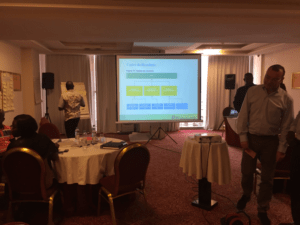
By: Armand Aquino ’17

Last May 9-12, I participated in Catholic Relief Services’ (CRS) first ProPack I training in French in Dakar, Senegal. ProPack I (or Project Package I) is one of CRS’ manuals on project design for CRS project and program managers. The training gathered more than 30 CRS staff from the West Africa and Central Africa country offices including Burkina Faso (where I currently serve as a Fordham Intern), Burundi, Cameroon, Central African Republic, Chad, Mali, Niger, Rwanda, and Senegal, among others.

I first came across CRS’ ProPack I in Dr. Schwalbenberg’s Project Design class where I learned the basic concepts of project design including problem tree analysis and the logical frameworks. The training, however, had more concepts added and it made these concepts more “practical” because they fall in a specific process of project design that CRS staff ought to follow. The process of project design itself was the most useful take-away for me, since I tend to jump from one step to another, when in fact, there is a logical flow that could make the work easier. For instance, when given an issue or problem, I tend to start with a problem tree analysis to identify the causes of the problem. However, conceptual frameworks can already do that for you since it has already made the connections between factors and the problem. What one can do then is to use these conceptual frameworks to specify the causes (scope, gravity, etc.) through research and assessment that will then help make the problem tree more “meaty” and easily convertible to a tangible results framework for the project.

In addition to the content, the facilitation of the training which used real-life examples and the opportunity to hear from the experience of various CRS staff in project design were enriching; it made the concepts more real and easier to understand. The training was also a great opportunity to continue practicing my French language skills since everything, including lectures, readings, and group work, was conducted in French and to network with some CRS staff in the region. I must admit I had a little difficulty in following some parts of the discussion since I am not yet fluent in the language. But what really helped me prepare for the training was reading the English version of ProPack I in advance so I have the concepts at the back of my head and I do the translation and connection in French as the training goes. Additionally, it was definitely helpful to have some experience in project design that I could bank on during the training (As an intern, I am involved in a couple of project design initiatives for the Burkina Faso country program).

Given the adventurer in me, I also used this opportunity to visit some superlative places in Dakar and get immersed for a bit in its history and culture. I visited the highest point in Dakar and the furthest West tip of the African continent.

I would like to thank CRS West Africa Regional Office and Burkina Faso Country Office for allowing me to participate in the training and Fordham IPED for financing my participation in the training. The training was definitely a good investment as I continue to explore a long-term career in the international development space.
